External links
- John Powell's playing statistics from AFL Tables
- John Powell at AustralianFootball.com

| John Powell | |||
|---|---|---|---|
| Personal information | |||
| Full name | John Powell | ||
| Date of birth | 11 March 1937 | ||
| Height | 184 cm (6 ft 0 in) | ||
| Weight | 74.5 kg (164 lb) | ||
| Position(s) | Centre | ||
| Playing career1 | |||
| Years | Club | Games (Goals) | |
| 1957–59 | Collingwood | 6 (2) | |
| 1960–63 | Fitzroy | 48 (12) | |
| Total | 54 (14) | ||
1 Playing statistics correct to the end of 1963. | |||
| Sources: AFL Tables, AustralianFootball.com | |||
John Powell is a former Australian rules footballer who played with Collingwood and Fitzroy in the Victorian Football League (VFL). [1]
He is the brother of Australian Olympic canoeist Adrian Powell. [2]
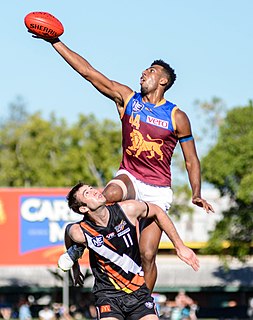
Australian rules football, also called Australian football, or simply called "Aussie rules", "football" or "footy", is a contact sport played between two teams of 18 players on an oval field, often a modified cricket ground. Points are scored by kicking the oval ball between the middle goal posts or between a goal and behind post.

The Carlton Football Club, nicknamed the Blues, is a professional Australian rules football club based in the inner-Melbourne suburb of Carlton North, Victoria. Founded in 1864, the club competes in the Australian Football League, and was one of the competition's eight inaugural member clubs in 1896.
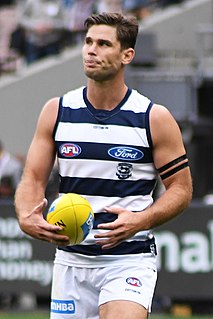
The Coleman Medal is an Australian rules football award given annually to the Australian Football League (AFL) player who kicks the most goals in the home-and-away season. It is named after John Coleman, a full forward and Australian Football Hall of Fame Legend who scored 537 goals in 98 games for Essendon. The award was first presented in 1981 to Richmond's Michael Roach, who scored 86 goals for the season. At the time, the competition was known as the Victorian Football League (VFL); it would become the AFL in 1990.
Allen James Aylett OBE is a former Australian rules football player and administrator. He was the chairman/president of the North Melbourne Football Club during the 1970s (1971–1976) and then again from 2001–2005. In between, he had been the chairman of the then Victorian Football League (VFL) which is now known as the Australian Football League from 1977 to 1984. Worked as a dentist throughout his entire career until his retirement at 81 years old.
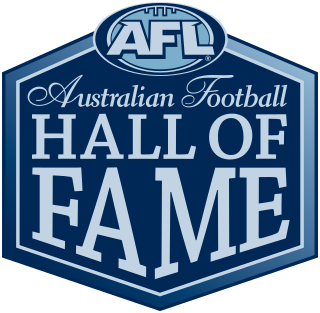
The Australian Football Hall of Fame was established in 1996, the Centenary year of the Australian Football League, to help recognise the contributions made to the sport of Australian rules football by players, umpires, media personalities, coaches and administrators. It was initially established with 136 inductees. As of 2014, this figure has grown to 257, including 27 "Legends".
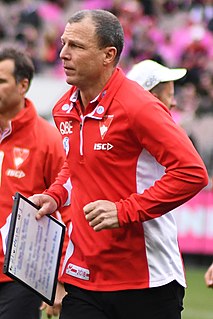
John Blakey is a former Australian rules footballer who played 359 games in the Australian Football League.

The Australian Football League (AFL) is the pre-eminent and only fully professional men's competition of Australian rules football. Through the AFL Commission, the AFL also serves as the sport's governing body and is responsible for controlling the laws of the game. Originally known as the Victorian Football League (VFL), it was founded in 1896 as a breakaway competition from the Victorian Football Association (VFA), with its inaugural season commencing the following year. The VFL, aiming to become a national competition, began expanding beyond Victoria to other Australian states in the 1980s, and changed its name to the AFL in 1990.

The Gold Coast Suns is a professional Australian rules football club based in the Gold Coast suburb of Carrara, that competes in the Australian Football League (AFL).
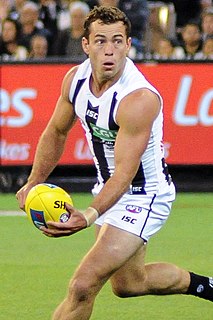
Jarryd Blair is a former Australian rules footballer who played for the Collingwood Football Club in the Australian Football League (AFL). Standing at only 174 centimetres, he is a small, pacy wingman/half forward flanker who made his AFL debut in round 14, 2010 against West Coast at Etihad Stadium.
The Australian Football League stages the highest-level senior Australian rules football competition in the country. However, since the late 1980s, when the former Victorian Football League expanded interstate to become the modern Australian Football League, there has not been a league-wide reserves competition; and, since 2000, there has been no dedicated reserves competition of any kind. As a result, AFL-listed players who are not selected in their senior teams are made eligible to play in one of the second-tier state leagues: the Victorian Football League, South Australian National Football League and West Australian Football League. The system used to accommodate AFL-listed players within these leagues varies considerably from state to state.
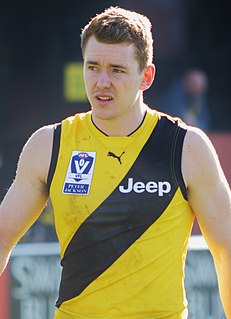
Jacob Townsend is a professional Australian rules footballer who plays for the Gold Coast Suns in the Australian Football League (AFL). He previously played 28 matches over four seasons with the Greater Western Sydney Giants and 20 matches over four seasons at Richmond. He won an AFL premiership with Richmond in 2017 while also winning the VFL's J. J. Liston Trophy that season as the league's best and fairest player during matches played with Richmond's reserves side, before winning a VFL premiership with the same reserves side in 2019. At the conclusion of the 2019 season, he was signed to the Essendon Football Club, and was delisted after one season, before being rookie-listed again, this time by Gold Coast.
Danny Powell was a former Australian rules footballer who played with Melbourne in the Victorian Football League (VFL).

Harold Powell was a former Australian rules footballer who played with Collingwood and Fitzroy in the Victorian Football League (VFL).

Richelle Cranston is a former Australian rules footballer with the Geelong Football Club in the AFL Women's (AFLW). She was drafted by Melbourne with their third selection and twenty-fourth overall in the 2016 AFL Women's draft. She made her debut in the fifteen point loss to Brisbane at Casey Fields in the opening round of the 2017 season. She was suspended for one match after her debut match due to front on contact with Brisbane's Jamie Stanton. After returning from suspension, she played every match for the year to finish with six games.

VFL Women's (VFLW) is the major state-level women's Australian rules football league in Victoria. The league initially comprised the six premier division clubs and the top four division 1 clubs from the now-defunct Victorian Women's Football League (VWFL), and has since evolved into what is also the second primary competition for AFL Women's (AFLW) clubs in Victoria. The league often runs concurrently with the Victorian Football League (VFL).
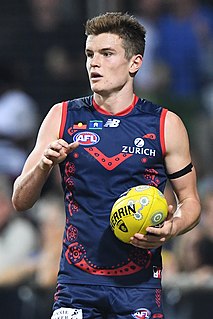
Bayley Fritsch is a professional Australian rules footballer playing for the Melbourne Football Club in the Australian Football League (AFL). A forward, 1.88 metres tall and weighing 81 kilograms (179 lb), Fritsch has the ability to play as both a high marking and small crumbing forward. Considered a late bloomer, he missed out on selection with the Eastern Ranges in the TAC Cup as a junior. After winning the league rising star in the Eastern Football League, he joined the Casey Scorpions in the Victorian Football League (VFL) where he spent three seasons. The 2017 VFL season saw him win the Fothergill–Round Medal, play for Victoria in the state representative match, be named in the VFL Team of the Year, and finish runner-up in the league leading goalkicker and Casey's best and fairest award. His season saw him drafted by the Melbourne Football Club in the second round of the 2017 AFL draft and he made his AFL debut in the opening round of the 2018 AFL season.

Fergus Greene is a former professional Australian rules footballer who played for the Western Bulldogs in the Australian Football League (AFL). He made his debut in round 19 of the 2018 AFL season against Port Adelaide at Eureka Stadium.

The AFL Grand Final, which is the final premiership deciding match each season in the Australian Football League (AFL), has been played at the Melbourne Cricket Ground in Melbourne, Victoria every year since 1902, except on six occasions when the ground was unavailable; and it is presently contracted to be played there until 2058. Despite the long-term stability in its location, and its natural fit as the largest stadium in Melbourne and Australia, the ongoing use of the Melbourne Cricket Ground has been controversial throughout its history.